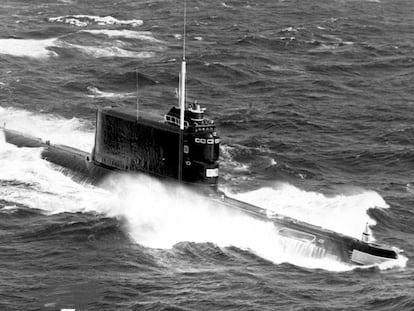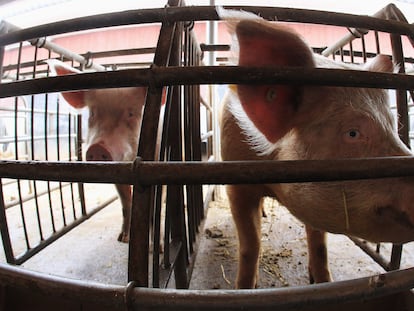Five men in socks and a happy driver: How the CIA ‘borrowed’ a Soviet rocket
At the time of the space race between superpowers, the spy agency managed to get hold of a crucial Russian device for a few hours

Among the many unimaginable episodes that transpired during the Cold War, few can top the time when the CIA kidnapped (they prefer the term “borrowed”) a Russian rocket. The operation, worthy of a James Bond movie, took place in 1959, but the agency did not release the information until forty years later, as part of its “Historical Review” program. Despite all the years that have passed, the official report does not reveal any details about who, where and when the mission was carried out.
It all started when the Soviet Union prepared a traveling exhibition to showcase its economic achievements: industrial products, machinery, textiles, furs, models of civil aircraft and the Lenin nuclear icebreaker – the usual in these cases. And of course, the best example of their technology and the envy of the recently created NASA: replicas of the first artificial satellites.
At the last minute, an unexpected item joined the presentation. It was the – life-size – upper stage of the carrier rocket of the first probes to the Moon. It measured 20 feet long by 11 in diameter. Freshly painted, three inspection windows had been cut on its side to allow a view of the interior. Inside there was a replica of the Luna 2 (also known as Lunik 2), the first object that had impacted our satellite.
A surprise for the CIA
When the exhibition opened in New York (other versions place it in Paris), CIA personnel made a routine visit and were stunned to find out that the rocket was not a simple display model, but an actual, authentic one. Except for some parts that it was missing – the engine and electronic components – it seemed complete. Could the Soviet Union be so proud of its space achievements that it had yielded to the temptation to show off one of its greatest secrets? It would be interesting to take a closer look.
The opportunity would arise at the following stop. The report released by the CIA does not specify the place, but later information places it in Mexico City, where the exhibition would be open to the public for a month between November and December 1959.
All its contents, but especially the rocket, were guarded day and night by security personnel. Approaching it was impossible, so a team of spies (“operatives” in CIA lingo) decided to wait for the show to close, when all the pieces would be loaded onto a train bound for the port of Tampico, in the northeast of Mexico. From there they would go to Havana.
The operative group consisted of five specialists. Following the rules of espionage, they arrived in Mexico on separate flights and stayed in different hotels under false identities. The team leader even suggested abstaining from eating very spicy Mexican food during the days prior to the operation in order to avoid gas, as they would have to work in a restricted, closed, and silent environment.
A night of pleasure for the truck driver
On the closing day a truck convoy was set up, heading for the railway station. The vehicle that was supposed to transport the enormous crate had a very convenient breakdown that delayed its departure for several hours. The checkers, considering their mission accomplished and not waiting for the last truck to leave, left to celebrate the end of a job well done.
After dark, with no guards around, the truck “miraculously” started, but instead of going to the station, it drove through some side streets that were practically deserted. It was escorted by two cars whose passengers made sure that no one followed.
Halfway there, the truck stopped and the CIA men convinced the driver to hand over the wheel to one of their own. Kindly, they accompanied him to a hotel where he would stay until the next morning, all expenses paid. The report does not describe in detail how he was kept amused; maybe money, tequila, some female companionship or a bit of everything.
The truck, covered with a canvas, entered a dilapidated lumberyard, a maneuver that was made difficult by the narrowness of the entrance. After a few minutes of waiting, they opened the top lid of the crate. Luckily, it showed signs of having been removed and put back several times before, so any new damage would go unnoticed.
More than a hundred screws
Then, guided only by their flashlights, the technicians jumped into the crate. The space between the rocket and the walls was minimal. One group set to unscrewing the front windows and another went for the rear plate, where they would be able to access the fuel tanks and the hydraulic system. There were more than a hundred metric screws; fortunately, this detail had been taken into account when selecting their tools.
The five men removed their shoes and worked only in their socks, so as not to leave any prints. For hours they took pictures of the interior and exterior. Eight rolls. At midnight, another car that was monitoring their movements took the film to the laboratory at the American embassy in order to have it developed and verify that the photos had been correctly captured.
Meanwhile, the men continued to scrape off metal filings, copy down the names of the manufacturers of each part, disassemble valves, measure the engine brackets, and wipe the remains of hydraulic fluid and kerosene that remained in the tanks.
The technicians who entered the nose section found an electrical outlet that was protected by a plastic seal bearing a soviet stamp. It had to be removed if they wanted access to the rest of the circuitry, so they broke it and sent the fragments to another specialist. Shortly after, the same car brought back another stamp, identical to the original.
A spotless operation
It was already dawn, and all that was left to do was to reassemble the removed parts, including the forged stamp. Then, check that the inside of the crate was clean, free of any revealing traces; close it and take the truck to the station, where the rest of the exhibition awaited. Along the way they would pick up the original driver, who was delighted with his adventure. The instructions were for him to park next to the other vehicles and take a nap while he waited for the Russian official in charge of the dispatch to appear, at around 7.00am.
He was unfazed. The list of packages was long and he did not know their contents. He simply put a checkmark next to the line that referred to the enormous parcel and that was it. A few hours later, all the crates were loaded onto a freight train bound for Tampico.
The loot of photos and data obtained in this operation allowed CIA specialists to estimate the weight and power of the rocket. Its weight was very close to the maximum load capacity of the main vector, the same one that had launched the Sputnik. The R-7 was a military missile, designed to launch thermonuclear devices. But with this additional stage, it became a perfect vehicle for planetary exploration.
Preliminary calculations suggested that a five-ton payload could be sent into Earth orbit with it (as, indeed, would happen two years later with Yuri Gagarin’s flight). Or a ton to Mars, or a hundred kilos to the Moon. History would prove how accurate those estimates were.
Tu suscripción se está usando en otro dispositivo
¿Quieres añadir otro usuario a tu suscripción?
Si continúas leyendo en este dispositivo, no se podrá leer en el otro.
FlechaTu suscripción se está usando en otro dispositivo y solo puedes acceder a EL PAÍS desde un dispositivo a la vez.
Si quieres compartir tu cuenta, cambia tu suscripción a la modalidad Premium, así podrás añadir otro usuario. Cada uno accederá con su propia cuenta de email, lo que os permitirá personalizar vuestra experiencia en EL PAÍS.
¿Tienes una suscripción de empresa? Accede aquí para contratar más cuentas.
En el caso de no saber quién está usando tu cuenta, te recomendamos cambiar tu contraseña aquí.
Si decides continuar compartiendo tu cuenta, este mensaje se mostrará en tu dispositivo y en el de la otra persona que está usando tu cuenta de forma indefinida, afectando a tu experiencia de lectura. Puedes consultar aquí los términos y condiciones de la suscripción digital.
More information
Últimas noticias
NASA discovers Titan doesn’t have an ocean, but a ‘slushy ice layer’ that increases possibility of life
Innocence lost in the forest of the child soldiers: ‘Each leader of the armed group had his girls’
‘Fallout’ or how the world’s largest company turned an anti-capitalist apocalyptic Western into a phenomenon
From inflation to defending migrants: Eileen Higgins and Zohran Mamdani inaugurate the new Democratic resistance against Trump
Most viewed
- ‘El Limones’ and the growing union disguise of Mexican organized crime
- Christian Louboutin: ‘Young people don’t want to be like their parents. And if their parents wear sneakers, they’re going to look for something else’
- The low-cost creative revolution: How technology is making art accessible to everyone
- ‘We are dying’: Cuba sinks into a health crisis amid medicine shortages and misdiagnosis
- Liset Menéndez de la Prida, neuroscientist: ‘It’s not normal to constantly seek pleasure; it’s important to be bored, to be calm’











































